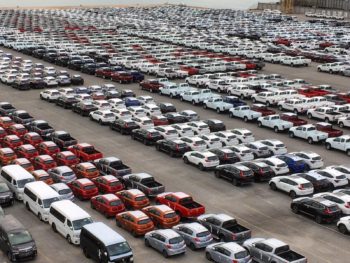UK registrations of new light commercial vehicles rose 4.9% in April, helping to regain ground on pre-pandemic levels.

A total of 22,665 new LCVs were registered in April, according to new Society of Motor Manufacturers and Traders (SMMT) figures, marking the fourth month of growth. Vans weighing over 2.0 tonnes and up to 2.5 tonnes saw the greatest growth, more than doubling to reach 4,318 registrations.
Notably, the 4×4 segment surged by 370.5% to 574 units, putting it ahead of vans weighing up to and including 2.0 tonnes, which became the smallest sector as registrations fell 48.2% to 428 units.
Deliveries of pickups also declined, falling 7.6%, while vans weighing greater than 2.5 to 3.5 tonnes fell by 6.2%. However, at 15,205 units this remained the largest market segment with a 67.1% market share, reflecting the general trend towards larger vehicles.
Battery electric vehicle (BEV) uptake soared in April, up 62.6% to 1,494 units and a market share of 6.6%.
April’s growth brings the year-to-date figures to 109,937 new vans, up 14.6% year on year and closing the gap to 13.7% on pre-pandemic levels. Meanwhile, BEV registrations for first four months of the year are broadly in line with the overall market growth at 14.8% and BEV market share for 2023 remains static at 5.4%.
The LCV market growth, supported by easing supply chain disruption, means that the overall market outlook for the year has been revised upwards from January, despite the continued challenging economic situation. The industry now predicts some 326,000 new LCV registrations by the end of the year, a 15.4% increase on 2022 and a 1.4% increase on January’s outlook.
But the sector has downgraded the 2023 BEV market share forecast – from 8.6% to 7.4% – against the challenging economic backdrop. The SMMT noted that high energy costs, limited incentives and inflationary pressures mean that the important total cost of ownership calculations are often negative.
It also warned of a paucity of van-dedicated infrastructure, along with delays to grid connections which combine to hamper operators’ ability to make the switch.
BEVs are still expected to account for 11.3% of registrations, equal to some 39,000 units, by the end of 2024, but this is also a downgrade from January’s outlook of 12.2% and the SMMT says the obstacles must be tackled.
Mike Hawes, chief executive, commented: “Four months of growth signals recovery is in sight for the van market, with easing supply chain issues raising confidence and boosting the overall market outlook. Ongoing economic uncertainty, however, must be addressed to help sustain and expand EV uptake. To ensure green growth that decarbonises the UK, the ever-growing choice of electric vans delivered by manufacturers must be backed by the right infrastructure and incentives so more businesses can confidently make the switch.”
Vauxhall has also published its own figure, revealing that it accounted for more than one in three fully electric vans sold in the UK so far this year.
The brand held 36.6% of the eLCV market for the first four months of 2023, with 2,344 vans sold.
The Vivaro Electric and Combo Electric were the UK’s two best-selling eLCVs in April, with 557 and 178 units sold, respectively.
The Vivaro Electric also remains the country’s best-selling eLCV YtD, having reached 1,794 sales in the first four months of the year.
James Taylor, managing director, said: “Electric vans are a fast-growing segment as businesses and fleets look to reduce their overheads and emissions. Vauxhall accounting for more than a third of the market share shows just how positively businesses perceive our products and services.”

